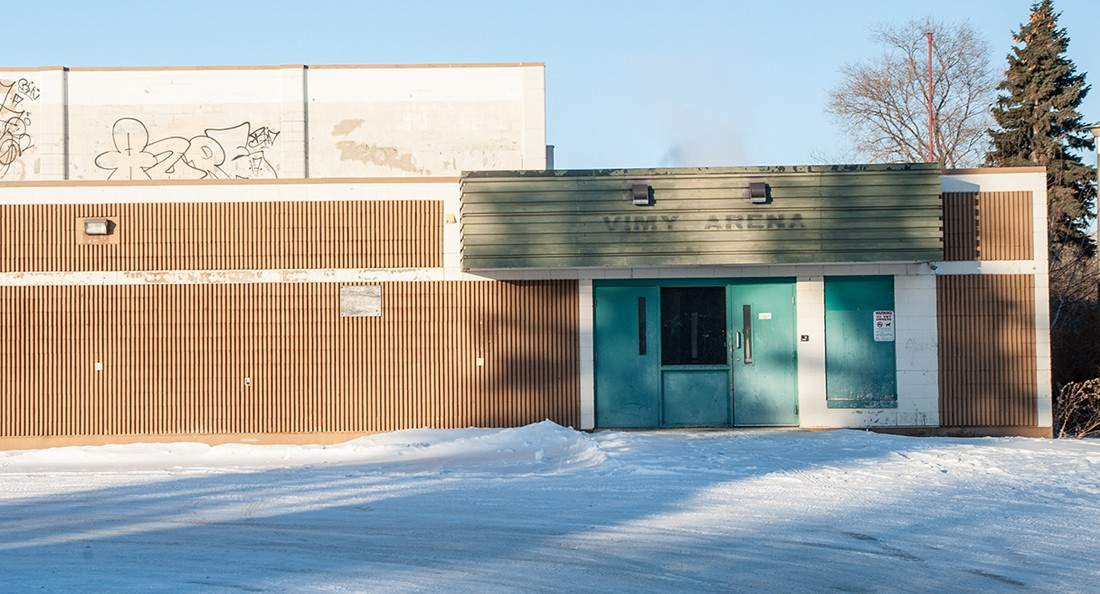Filling in the gaps
Addictions survivors discuss barriers to adequate care in Manitoba
This summer, heated debates erupted in the St. James neighbourhood at an information session about the Bruce Oake Recovery Centre, a new addictions treatment facility that is set to be built in the area.
On one side, a group of residents argued that the centre should not be built in a residential area. On the other, many of their neighbours vouched to end stigma against addictions and insisted that the establishment of this recovery centre was non-negotiable.
Among those in support of the centre were Christie Paul and her son Bruce. They’re from St. James and have battled addiction in both personal and professional capacities.
Christie has worked at the North Point Douglas Women’s Centre (NPDWC) for about 10 years, doing both frontline and programming work with people from the North Point Douglas community.
Advocating for women who are struggling with addiction is a present factor in all the work the centre does. So when Bruce came to Christie to ask for help with his addiction, she says “it made everything much more real.”
With a support network of people, including his mother and well-known social worker Mitch Bourbonniere’s mentorship program, Bruce eventually made it to treatment at River Point Centre.
During his recovery process, he met a group of young people who had also been through the addictions system in Winnipeg. They now live together in a house in the West End.
Bruce, Cooper, Sophie and Manny are all presently in recovery and are involved in a 12-step program. They have meetings almost every day.
Gaps in care
Although the four roommates admittedly come from areas of Winnipeg that are economically comfortable, including St. Vital, St. James and River Heights, only Manny had access to private programming to treat his addiction, and he was only offered this treatment after he had been incarcerated.
“My family reached out through my lawyer,” he explains, noting that there was little addictions assistance offered by the jail itself.
The others cited accessessing a number of different treatment programs through organizations such as River Point Centre, Addictions Foundations of Manitoba (AFM), Tamarack Recovery Centre and Whispering Pines Addiction Treatment Centre. The group unanimously agreed that if someone doesn’t have a lot of money to spend on an expensive private program, accessing adequate care can be very difficult, and getting immediate help is often impossible.
Unless someone is able to afford private care, which usually costs thousands of dollars, the time after deciding to get clean can feel like a tedious waiting-game.
If detox is required, as it usually is after substantial use of opiates, meth and/or alcohol, among other drugs, the first step is to get a doctor’s note granting approval for detox.
Cooper explained that doctor’s notes usually only medically clear people for detox for about 72 hours.
Cooper says that in the past, after getting a doctor’s note, a person “had to hope and pray that there was a bed available (within) the next three days.”
In Winnipeg, most people who cannot afford to pay for private treatment seek out detox services at Main Street Project (MSP). The Health Sciences Centre also has a limited capacity for detox, but as the roommates point out, these services are only available to people who are medically considered to be in extreme danger. Those in need of detox who cannot afford to pay thousands of dollars must generally make two trips: first to the doctor’s office and then to MSP.
Rick Lees, executive director of MSP, explains that over the past few years, the organization has made substantial efforts to reduce and even eliminate waitlists. “We really tightened that up,” he explains. “We’ve added more beds.”
Rick Lees, executive director of Main Street Project // Supplied image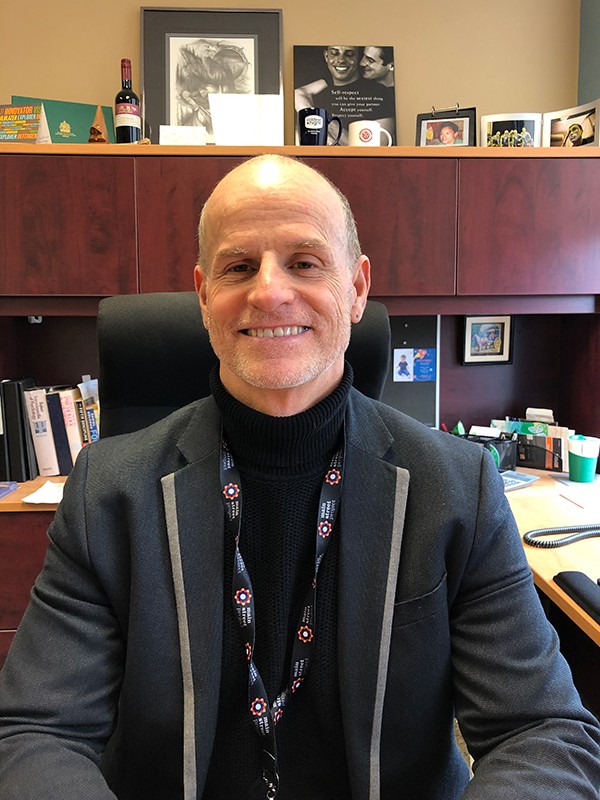
The Health Sciences Centre and St. Boniface Hospital emergency departments now both have dedicated beds at MSP. All five Rapid Access to Addictions Medicine (RAAM) clinics in Winnipeg also have dedicated beds in the MSP facility.
“When people are coming through urgent treatment processes, we are trying to ensure that there is the right continuum to get them into the stabilization process,” Lees says.
Lees thinks one of the major challenges the system currently faces is establishing a “good continuum from detox to stabilization.”
“Often, people will go through the detoxification program, which might take anywhere from 10 to 20 days, a bit longer if it’s meth, and then discover that there’s no treatment bed. Or there’s a treatment bed that’s two weeks out,” he says.
Long gaps between detox and treatment can mean that many people have no choice but to return to negative environments, and they frequently will go back to using again, Lees explains.
“There’s gaps in care at every step,” Cooper says. “People who are homeless are still homeless in between.”
Sometimes, the wait time to get into treatment can be much longer than two weeks. Cooper says he waited for six weeks for intake through RAAM three times. Each time, when he finally got there, he no longer wanted help.
Sophie explains that, in her experience, women's AFM services usually have a three-month wait, and that’s “just to fill in the paper. It’s first come, first served.”
“You have to arrive there at, I think, eight in the morning. There’s only a certain amount of people that can come in to fill in the paper. And if you’re too late, you’re rejected, and you have to come back the next week. It’s just nuts,” she says.
The North Point Douglas Women's Centre on Austin Street North // Photo by Daniel Crump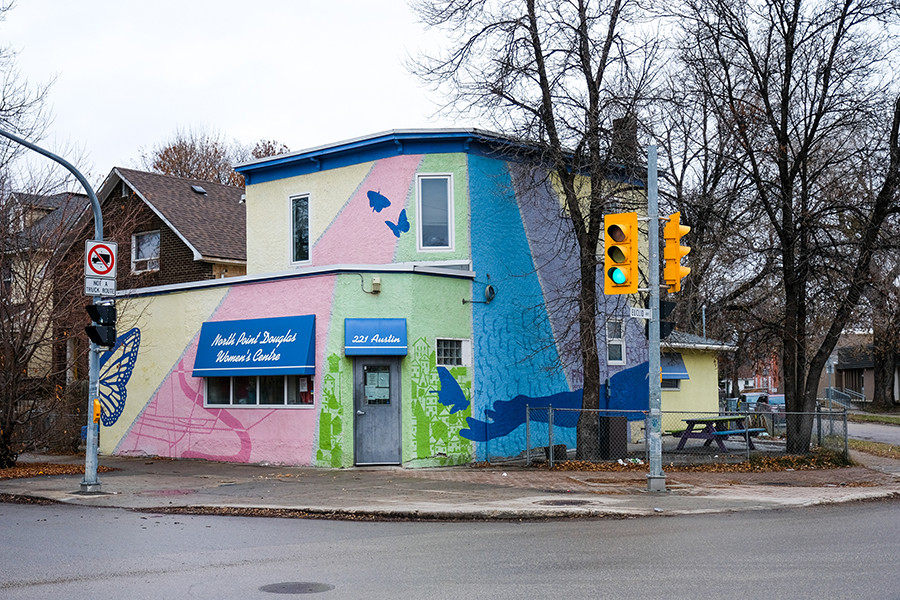
Barriers upon barriers
After experiencing firsthand what it was like supporting a family member through addiction, Christie believes that “it doesn’t matter where you come from, (since) we can all be affected by these things.”
She adds that she is also careful when she says that. “There’s systemic racism that has impacted whole communities, so I don’t want to minimize that impact either.”
For example, she discusses a young woman who has sought help from NPDWC to recover from her addiction, but “it just hasn’t happened yet ... there are so many barriers to getting her the help that she needs.”
One of the factors that heavily impacts the lives of Indigenous women struggling with addiction is Child and Family Services (CFS).
While Indigenous children make up about 26 per cent of the child population in Manitoba, they made up 89 per cent of children in care in 2017. Lees explains that 65 per cent of women who access detox facilities at MSP are Indigenous, and that 42 per cent of all the women in detox are dealing with CFS.
In these archival photos from March 2018, members of Bear Clan's North End Patrol gather discarded needles and other drug paraphernalia // Photos by Daniel Crump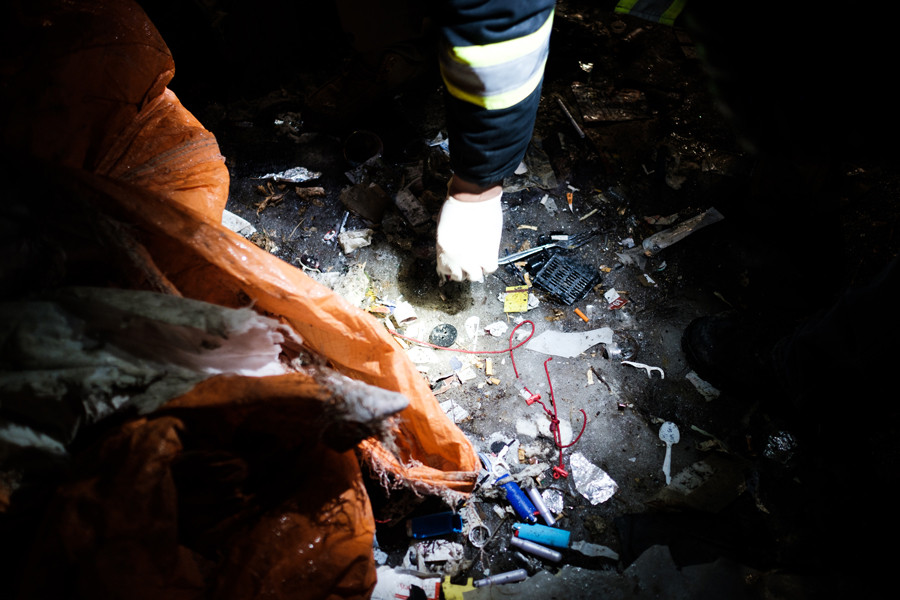
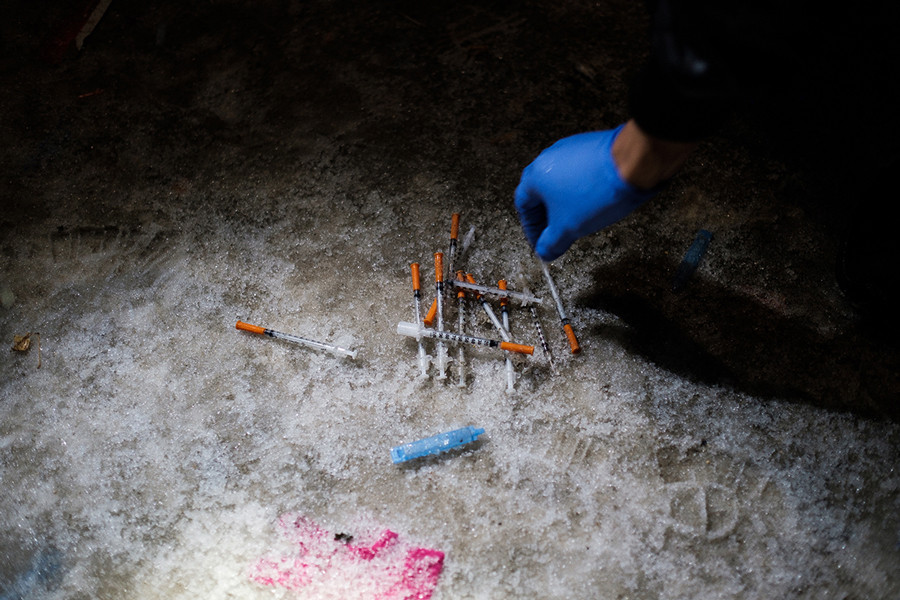
In addition to the physical and mental trauma that usually accompanies addiction, many women are also dealing with the trauma of having their children taken away. Lees explains that one of CFS’s conditions is that women struggling with addiction need to access detoxification and treatment in order to get their kids back.
“They can’t access support,” he adds. In the interim periods between detox and treatment, many women facing multiple barriers are likely to go back to using. It’s really challenging,” Lees says.
Christie says there are simply not enough treatment centres for women in the city and mentions that “It’s easier to build a men’s recovery program.”
At the Bruce Oake information session, she spoke with a staff member from a Calgary project that the Bruce Oake facility is being modelled after.
“We were asking about programs for women . . . he said so far they haven’t done it, because it’s much more complicated, because you have to figure out what to do with their children,” Christie explains.
“Bruce Oake will only be for men. River Point is only for men,” she adds.
Healing-based approaches
Bruce, Cooper, Sophie and Manny are living proof that recovery is possible, but that it cannot happen without overcoming odds that oftentimes feel insurmountable.
In addition to the gaps in the continuum, the forms, the calls and the often-inaccessible hours during which many organizations are open, the system takes a significant emotional toll on people seeking care.
If a person does not have external support systems, which all four of the roommates mentioned having in at least some capacity, making it to and through treatment becomes even more challenging.
Bruce says that “it’s a very small window for when an addict wants help to go into detox ... If it’s not in that moment, then that willingness will be gone.”
“I feel like if I could just walk them down somewhere,” Christie says, referring to the women she works with who are battling addiction. “Let’s just go right now! And walk in, you’re ready right this second. Let’s go!” she says, but “a person can only be ready when they’re ready.”
Without any external support, being ready can be tough. This is why in addition to promoting a harm-reduction approach to treating addiction, Christie explains that the NPDWC’s programs are also healing-centered.
“It’s a growing understanding that we’re gaining,” she says. “A lot of the healing work we’ve done demonstrates that if you can create a sense of connection and belonging in some form and create some kind of safe place that people feel they belong, that can be a very good starting point.”
“It’s not really something you can do on your own,” Bruce says, referring to the support network he has gained through 12-step programs and living in community with his roommates who have shared similar experiences.
’The opposite of addiction is connection‘
The “not in my backyard” mentality of the anti-Bruce Oake protestors is still a prevalent voice in conversations about addiction, focusing on defining “us” versus “them” instead of exploring the ways that healing can be achie ved for everyone.
When people view addiction as a moral failing that only exists in external communities, they fail to see that addiction is a symptom of a system that is sick, and that they are a part of that system.
“When we continue to have oppressive structures that impact people’s lives and push them to these breaking points, we have a responsibility, too,” Christie says.
Although there are many dedicated individuals working in the field who care deeply about humanizing the experience of addiction, there is still a long way to go before the system can become accessible to everyone.
One step toward achieving accessible treatment and care could be by advocating for addiction to be treated as an illness, Lees suggests.
“It shouldn’t be politicized,” he explains. “These are illnesses and diseases the same as HIV and the same as diabetes, the same as heart-disease, the same as cancer.”
Lees says that the sooner people stop politicizing addiction, the sooner it can be treated in the public system with realistic approaches like harm reduction.
Another important step could be facilitating community and dialogue in spaces where people are struggling with addiction, so people can start to feel held by those around them who empathize with their struggles and who have shared similar experiences.
Christie remembers the moment after Bruce first told her he needed help. She picked up the phone and called Bourbonniere.
He said “I’ll call you back in five minutes. I’ll get my best guy on it,” Christie recalls. Within 24 hours, Bruce was paired up with an action therapist who stayed connected with him until he got into treatment.
Bruce’s action therapist had a history of addiction as well, which provided him with a sense of community and solidarity.
“This was the first person I’d talked to who understood what I was going through, and that was enough for me to be willing to get help,” he explains.
“They pulled him into their family, and they said ‘okay, you’re with us now,’” Christie recalls. “The opposite of addiction is connection.”
For addictions support, call the Addictions Help Line at 1-855-662-6605 or visit mbaddictionhelp.ca/services/partner-organizations for a list of groups in the province.
Published in Volume 74, Number 11 of The Uniter (November 21, 2019)

